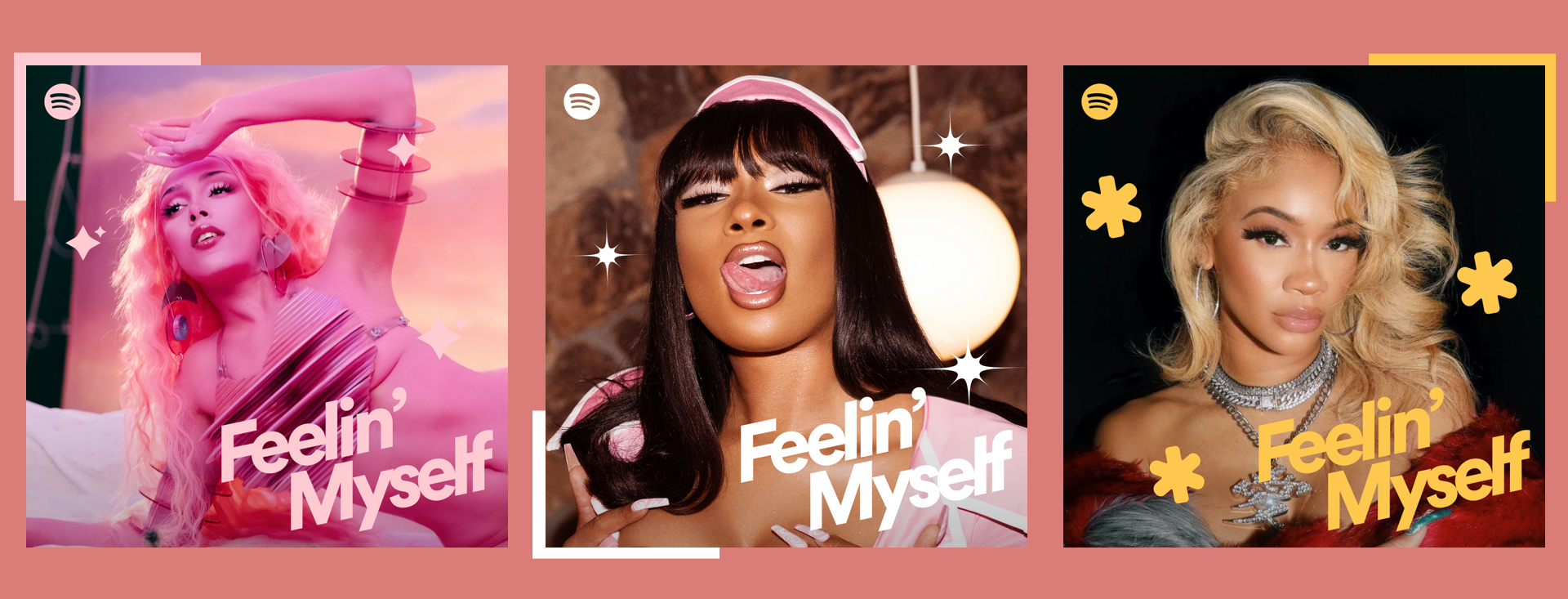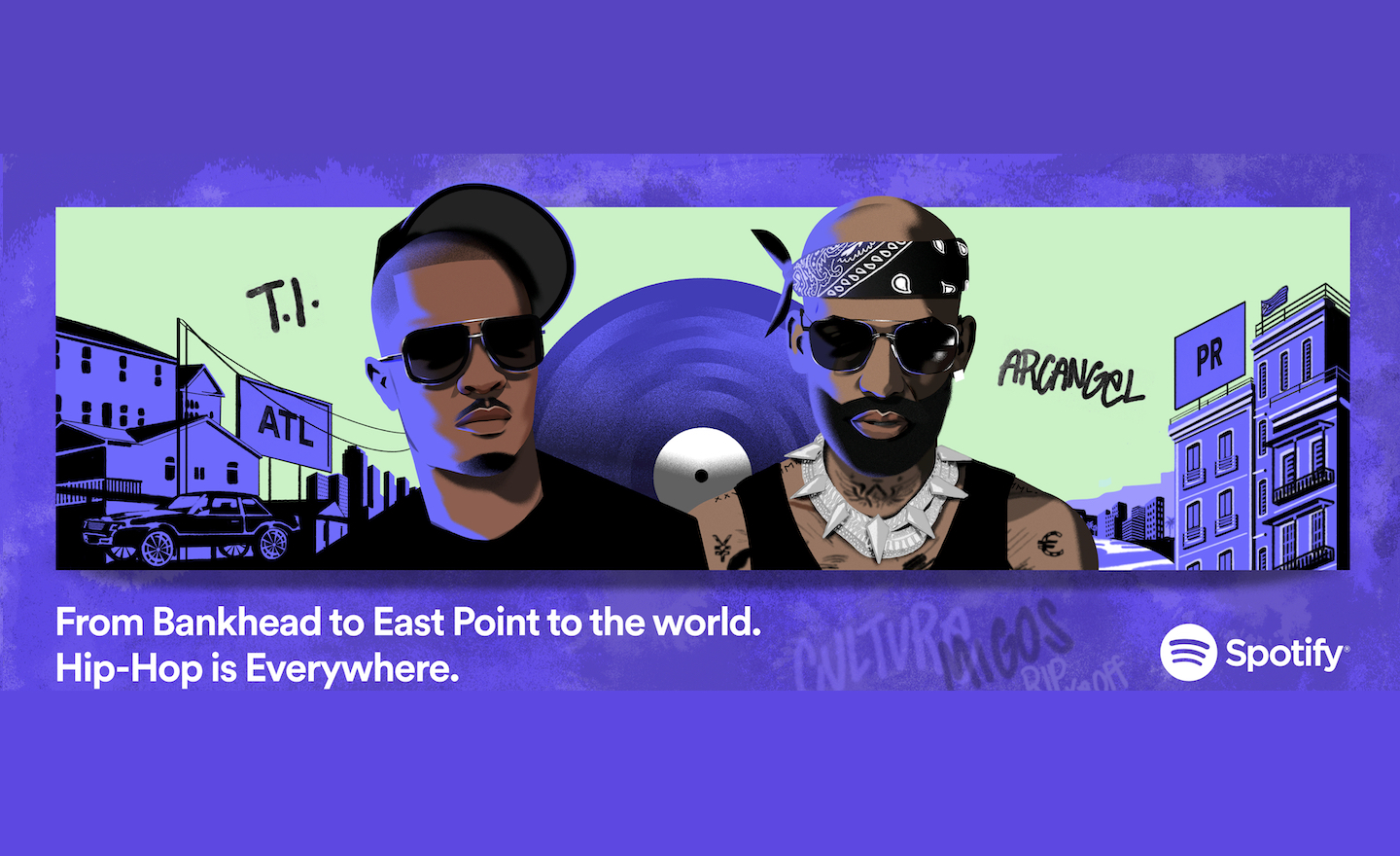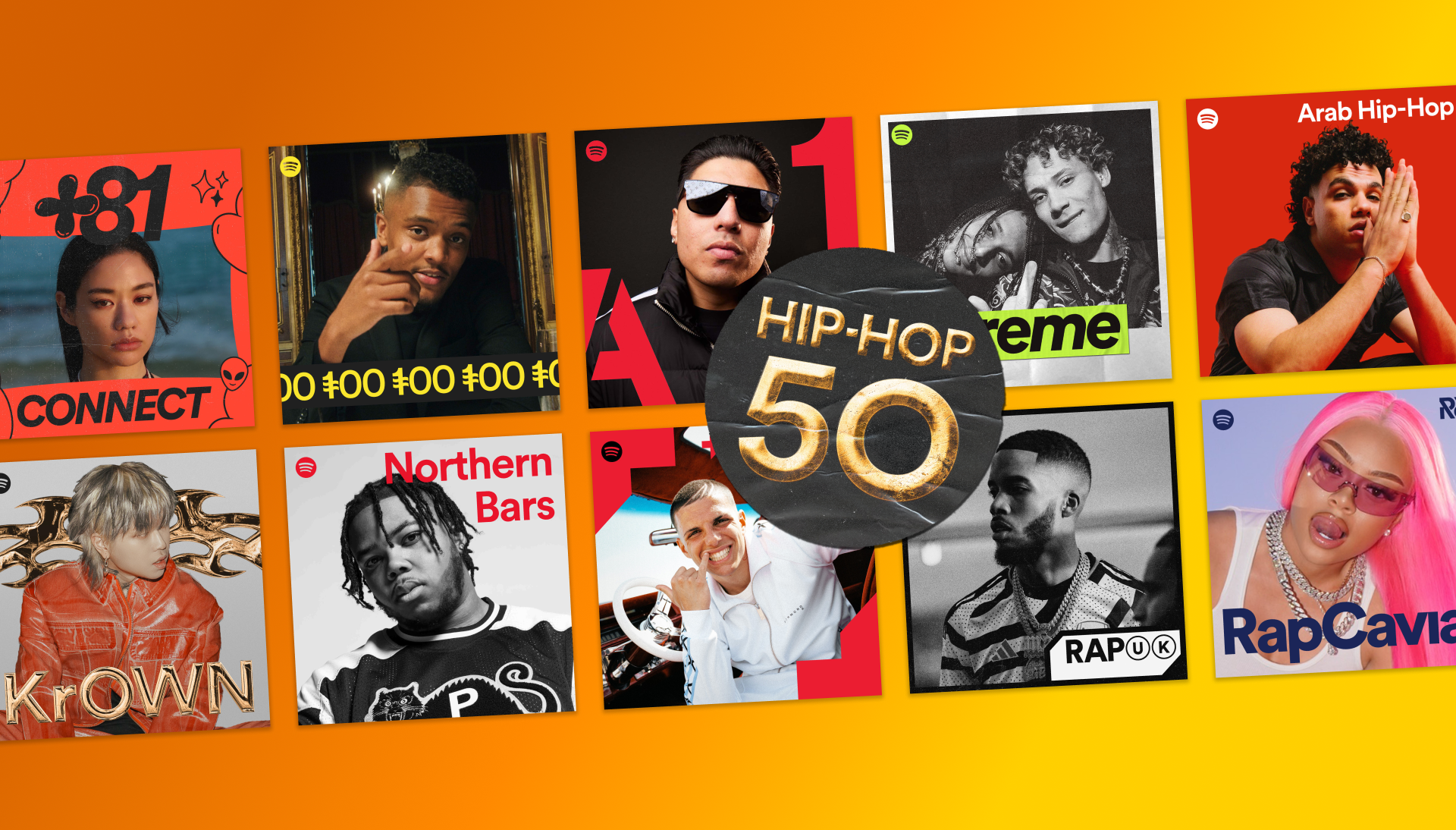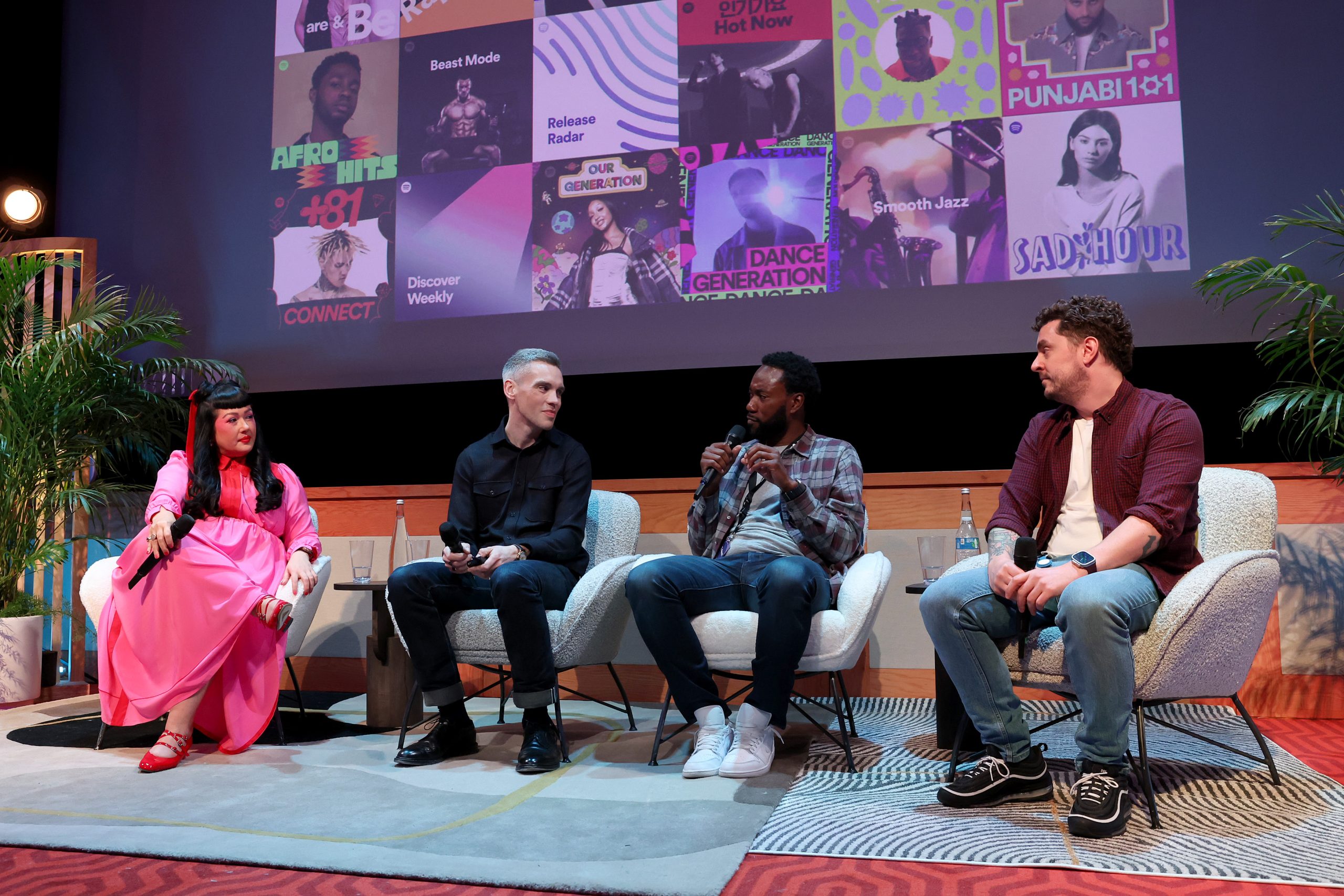
Hip-hop’s new golden age is here, and it’s being led by women. There’s arguably more female rap stars now than ever before in hip-hop history, and these women—including City Girls, Cardi B, and Megan Thee Stallion—have influenced the taglines and catch phrases that are now part of the cultural vernacular. Yet, the majority of Spotify hip-hop playlists still have a predominantly male listenership.
In 2019, Spotify launched a new playlist, Feelin’ Myself to start to equalize the barriers to entry for female rappers. The playlist has since become the second-fastest-growing hip-hop playlist on Spotify with over 1.7 million followers. And starting today, we are launching a full-scale campaign to transform the playlist from innovative to truly impactful.
Carl Cherry, Spotify’s Creative Director, Head of Urban, developed the idea for the playlist a few years ago, and formed a passionate team to help make it a reality. One member is Sydney Lopes, Spotify’s Head of Hip-Hop and R&B, Artists and Label Partnerships. We brought the pair together to discuss the campaign, the importance of spotlighting female rappers, and where the playlist goes from here.
Sydney Lopes: Can you explain the essence of Feelin’ Myself? How did the playlist come to be?
Carl Chery: The essence of Feelin’ Myself is confidence, edge, and high self-esteem. If you look at the songs that have been playlisted on Feelin’ Myself over the course of the last year and a half, there are a few songs that really embody the playlist. I’m thinking about Erica Banks, “Buss It” or “Best Friend” from Saweetie or even “WAP” by Cardi B and Megan Thee Stallion. They exude confidence, self-esteem, and sexiness.
The playlist came about because there’s an industry-wide gender bias when it comes to women. It came about as an attempt to level the playing field. “What can we do to create a space where women can thrive?” The first step was really reaching out to my female colleagues to see how they felt about creating a space for women only. The answer was to create a space where women can thrive—and then go on to other playlists.
Sydney: This isn’t the first time we’ve seen women in hip hop, but it’s the first time there seems to be a dedicated platform and playlist for them. What makes this the right time for it, and what would the mood of the playlist be if this playlist was created 20 years ago, for the rappers who were in the game?
Carl: Wow. Well, 20 years ago, I think it would have been a little bit more split in terms of the aesthetic of the playlist. It wouldn’t have been all women who are from the lineage of Lil’ Kim. There would have been Lauryn Hill, Da Brat—there would have been like a little bit more diversity 20 years ago. But right now, trap is the dominant sound. It’s not only specific to women—there’s always a dominant aesthetic in hip-hop—same around RapCaviar. They want to hear Saweetie, they want to hear Doja Cat, they want to hear Cardi.
But also, from the time we had the idea for the playlist, to the time it launched, to now, the field is completely different. When we first had the idea, we actually would have struggled to find artists to populate the playlist. We probably would have added a few male artists with big female fan bases, to just round it out and make sure there was enough music. I don’t think Doja Cat was having a moment just yet. I don’t think Meg was what she was just yet. But by the time it launched there was enough, and now a year and a half later there’s just a lot more activity like that. The timing couldn’t have been more perfect.
Sydney: On our team, we constantly talk about all the different sub-genres of hip-hop, but we’re always thinking about men, right? We talk about lyricists, we talk about West Coast versus East Coast, Down South, trap; we never really think about how that applies to women. As more female rappers enter the landscape, I’m curious about how we will start to think about the sub-genres and how they apply to women.
Did you have a specific vision of how you wanted this campaign to roll out? What was your thinking around the energy you wanted to bring to the campaign?
Carl: Feelin’ Myself is the second biggest, second-fastest-growing hip-hop playlist on Spotify. I knew it was something that needed to be marketed. So, part of the idea or the goal was to have the playlist become such a destination for women in hip-hop that some of these women would then migrate to other playlists, and hopefully change the audience and in turn, help improve the performance of songs by women on a lot of those playlists. We’re starting the campaign by featuring women on all of our hip-hop covers, and they’re going to remain there the rest of the month of June.
A lot of it was more collaborative—I had shells of ideas—but I have to give credit to the team, it was important to have a full female team behind this. The director, Jillian Iscaro; visual identity artist Laci Jordan; the production company, Spang TV; and some of the merch, designed by Divine Individual, all of that was created by women.
Sydney: We’re even seeing female vocalists and lyricists on the playlist. You’ve got SZA, Yung Baby Tate, talented singers, too. There’s a wide breadth of what could be on this playlist and a part of this brand.
And so, as our first big push on the marketing side for this playlist, not only are we gonna make sure that editorial is supporting in a significant way on platform, but we’ll have a couple of social ads featuring Coi Leray and Iamdoechii, who are rising artists right now that have made an enormous impact in what feels like a really short amount of time. Carl, can you speak to the reason for choosing these two artists and bringing their energies into this campaign?
Carl: Coi Leray is arguably the hottest rapper who just happens to be a woman right now. We talked about diversity earlier—her style is different. I hate making comparisons because I think it’s unfair, but she reminds me of a female Playboi Carti, a little bit. She’s fearless. And Iamdoechii is different because she’s a little bit lesser known, but she’s one of the earliest examples of a woman being playlisted early on Feelin’ Myself, and her song taking off and being on the trajectory of potentially becoming a hit. She’s unique. She has duality.
Sydney: Right, and this is really just the beginning, just the first time we’ll be doing something of this nature. And our hope is to bring this back to life in some way when the pandemic is over. Our RapCaviar Live show that featured all women was one of the most successful RapCaviar Live shows we ever had. We’re hoping we can do something similar. Do you see Feelin’ Myself making an impact in culture the way RapCaviar has?
Carl: One hundred percent. It’s already happening more than we know. The campaign is not only about Feelin’ Myself, it’s a campaign celebrating women in hip-hop and the moment that they’re having. Sydney, what do you think needs to happen to break down barriers to entry?
Sydney: One part is dialogue. A huge part of it is listening, for the gatekeepers. There are not enough women who are considered the gatekeepers. It’s about providing opportunity. It’s about taking a risk on things that haven’t been done before, in a way we haven’t seen before—and doing so in a way that isn’t performative. We need to be a lot more collaborative, we need to listen to women, and let them do what’s never been done.
No matter what you’re feelin’, there’s no better time to stream the women of hip-hop. Check out Feelin’ Myself below.








Recent Comments